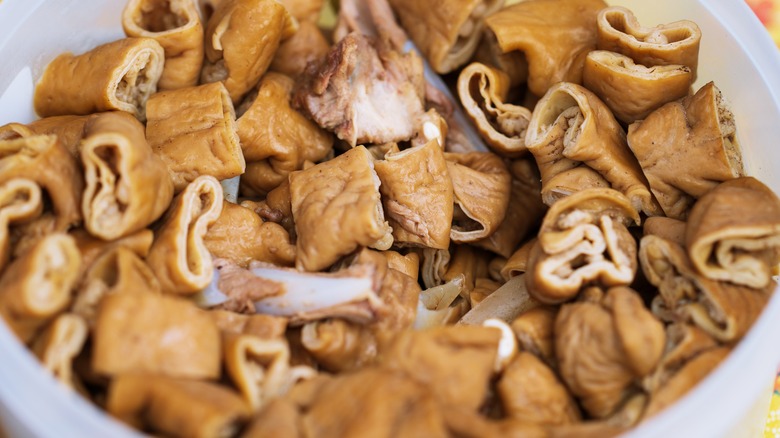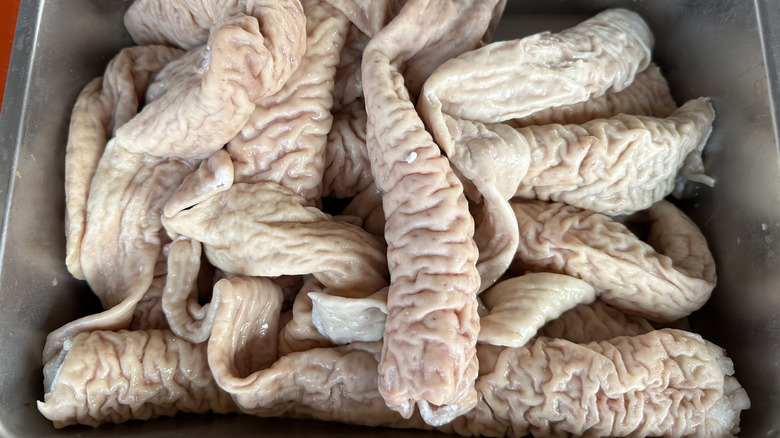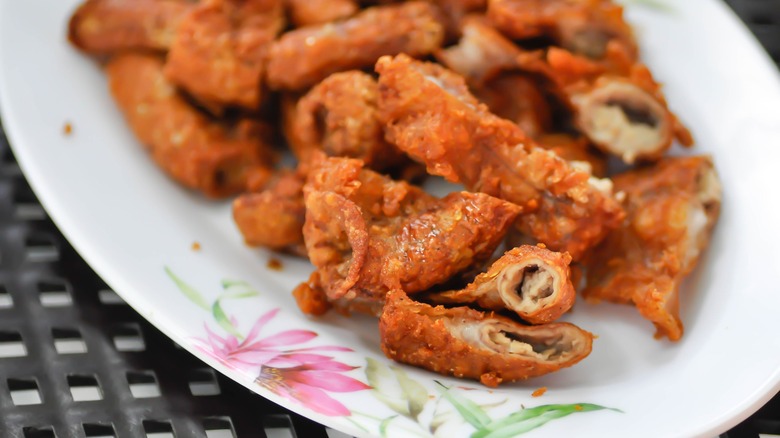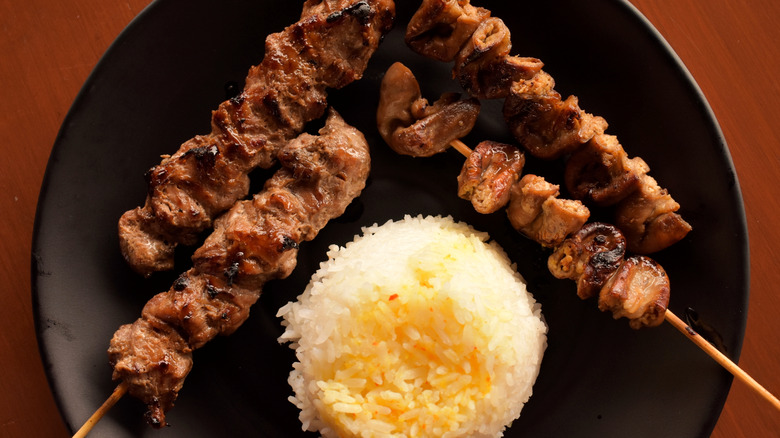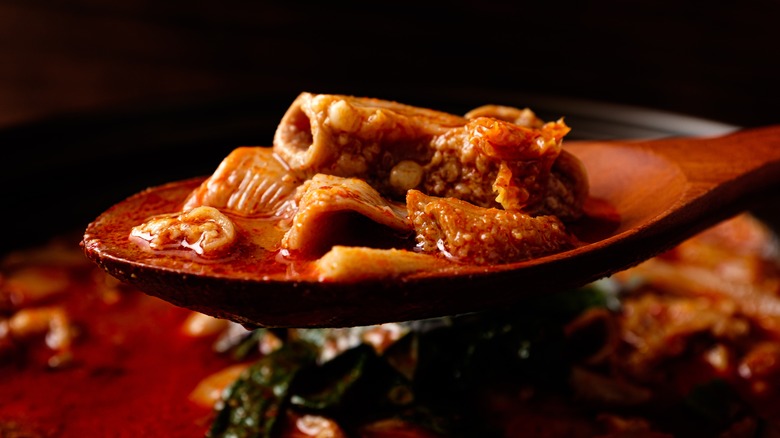Pork Bung Is The Pig Part You Should Start Cooking With
You may not be able to judge a book by the cover; but, sometimes, you really can tell what an ingredient is by its name. As is the case with pork bung, which refers to a pig's large intestine where part of the colon — and, yes, rectum — are. But before you clutch your pearls and decide the ick factor is too much, consider that the intestines of an animal are just a part of the offal meat category, the same as the gourmet, beloved French sweetbreads. And, as such, they have a lot to offer the culinary world.
Much like other organ meats, pork bung is often discarded due to its less-than-pretty function in a pig's life; but it also has rich flavor, fat, and a certain hard-to-describe gameyness. So, if you're someone who believes in the philosophy of using each part of the buffalo, consider using each part of the pig by learning more about pork bung and how to enjoy it.
What is pork bung?
Just like humans, pigs have a digestive system that consists of a mouth, esophagus, stomach, and both a small and large intestine. Pork bung only refers to the large intestine portion, which is where the final stage of digestion occurs, containing both the colon and the rectum. In its raw form, pork bung looks like a sausage-sized reservoir (the rectum) with a wide tube attached (the colon).
According to "Nutritional Physiology of Pigs," a book published by Videncenter for Svineproduktion, "Adult pigs have a large intestine weighing approx. 2.8 kilograms, with a length of 7.5 meters and a capacity of 25 liters." Younger but no longer suckling pigs of about 100 kilograms have a large intestine with a 10-liter capacity by comparison. To put things in perspective, 2.8 kilograms is about 6 pounds, making this a pretty hefty cut of offal. Of the pork-byproduct cuts — basically, the stuff you won't see in cellophane-wrapped packages in grocery stores, like loins or chops — the large intestine has the highest fat content. And, just like that fatty rind on the edge of your steak, pork bung has plenty of chewy, tender texture to work through.
Pork bung vs. chitterlings
Eating pig intestines isn't a foreign concept, not even in the United States. But the part you've probably heard of is chitterlings, which are also part of the pig's digestive tract, specifically the small intestine. This long tube of the colon has a narrower diameter than the bung, as well as less fat. The small intestine is more common in Western cuisines than pork bung, because the submucosa of the small intestines is used to make sausage and hot dog casings, which gives frankfurters that delightful snap when you bite into them. Pork bung is not used for this purpose.
When the small intestine is called "chitterlings," also colloquially known as "chitlins," it's exclusively in reference to the small intestine. Chitterlings can be made from nearly any mammal's small intestine, but most often refers to that of a pig. The small intestine can be cooked in a myriad of ways but is most commonly stewed or deep-fried in Creole and Southern soul food. Pork bung could also be eaten this way, but isn't yet as common a part of Western cooking and dining.
What does pork bung taste like?
It is often difficult to describe the taste of any offal meat, so the catch-all term is usually "gamey." This usually means that there's some tang that's hard to put your finger on, but that separates the taste of the meat from standard grocery store cuts. The way a bison steak might taste a bit different from a farm-raised cow is a decent comparison; but, in the case of an intestine, that difference is even more apparent. And, because our olfactory senses are so closely tied to our taste, it is also important to note that pork bung has a strong aroma of ammonia due to its function in the digestive system. However, that is usually diluted during the cleaning and cooking process.
But beyond the offal-y, gamey flavors, pork bung is still, well, part of a pig, and it tastes like it, too. Bung does taste porky and meaty but will have a lot more fat, funky smells, and texture to it than most cuts of pig meat. It is so chewy and tender that it was rumored (and by rumored, we mean totally unsubstantiated) that pork bung was being used as a calamari dupe. While there is absolutely no factual basis for this claim, it is true that pork bung has a very similar texture to calamari thanks to its fat coating that makes the meat almost sticky when chewing.
How to cook with pork bung
Pork bung is a versatile and affordable cut of meat to use, like many offal meats; and, as more folks try to make sustainable food choices, especially where red meat is concerned, it makes sense to try incorporating this pig part into your cooking. But, because of the function pork bung plays during a pig's life, you need to use the utmost caution during preparation and cooking. The rectum stores waste; so, even if your pork bung came pre-washed, you need to clean it yourself. You can do so by washing the inside and out very thoroughly with running water, soaking it in diluted vinegar, boiling it in water, then draining and cooking as desired.
As far as how to actually enjoy this meat? You've got lots of options. Just like chitterlings, pork bung would taste wonderful deep-fried and served with a tangy sauce. It could also be cooked in the Filipino isaw style, where pork bung is cleaned, boiled, sliced, skewered, basted in spices and soy sauce, then grilled. You could also toss it into a stew, similar to how tripe is used in menudo. If you find the smell of pork bung offensive, try to cook it with highly aromatic ingredients like onion, garlic, chilis, citrus, and plenty of herbs. Longer cooking times and diligent cleaning will also reduce the pungency of the bung.
Where to buy pork bung
As you might imagine, you won't find a package of pork bung sitting out in your grocery store next to the chicken breasts and pork roasts. To get pork bung, you have a couple of options. You can go to a Western butcher shop and ask if they have any, but you might have to request that the bung be preserved during a following pig butchering, as this offal meat is often discarded.
If you are lucky enough to live near an ethnic food market, you should definitely pay a visit. Pork bung is common street food in parts of Asia; so look to Asian meat markets, as well as food halls, to find pork bung — there are also plenty of Pan-Asian markets like H Mart that might have it.
The pork bung may be sold raw and fresh, but it might also be in the freezer aisle, as sometimes less-popular cuts of meat are frozen for preservation purposes; so be sure to check there as well. But, if you cannot find it, do as you would at any other butcher shop and ask for some. The term "pork bung" is what it's most commonly referred to as, but pig rectum might also suffice if the butcher doesn't know what "bung" refers to.
Nutritional information about pork bung
There is shockingly little information about pork bung's nutritional value. What little information does exist doesn't distinguish between the small and large intestines. However, it is known that pork bung is rich in fat, has a decent amount of protein, and has very low levels of carbohydrates, if any. Nutritional calculators estimate that the pig intestine holds approximately 200 calories per 3 ounces and accounts for 22% of the recommended daily intake for fat.
So, with all of that fat, is pork intestine healthy? While fat used to be the unofficial f-word of dieting and nutrition, recent diet trends and research encourage a low-carb, high-fat diet. Fat in itself is good for the body, as it aids in the absorption of certain vitamins and provides our body with fatty acids. But not all fat is equal, and whether or not it's good for your health really comes down to how it impacts cholesterol and whether you consume it in moderation. Nutritionally speaking, a diet should prioritize fats in the following order: unsaturated, saturated, and trans, with the three types going from better to worse in terms of cholesterol impact. Pig intestine has about 7 grams of unsaturated fat, 8 grams of saturated fat, and no trans fats. However, even though the intestine doesn't carry trans fats, one serving accounts for 78% of the daily recommended cholesterol intake, high levels of which are associated with heart disease. Essentially, pig intestine, like all animal products, should be consumed in moderation as part of a balanced diet.
